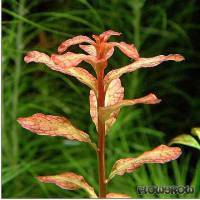



Ludwigia senegalensis is relatively new in the hobby. Its interesting leaf pattern, together with its brick-red colour, distinguishes it from other stem plants. It first was introduced as Ludwigia sp. "Guinea". This name hints at its being imported from Guinea first, however, information is scarce. L. senegalensis is rather widely spread in Africa - from Senegal to Angola and to the Zambezi river in northern Zambia - where it grows in different wet locations, emersed and submersed, up to a height of 1100 m above sea level.
When cultivated emersed, the plant develops a creeping growth habit, whereas its submersed shoots grow upright.
As breathtaking as this plant may be, it needs some things for optimal growth. First and foremost, it needs a lot of light and should thus not be placed in the shade or in poorly lit areas of the aquarium. A good supply of micronutrients is a must, too, as its shoot tips tend to blacken and may even die off if there is a deficiency. Fertilise with around double the dosage as given by the manufacturer. Macronutrient levels should also be ample, as L. senegalensis grows to its full potential with nitrate at around 20 mg/l and phosphate at around 2-3 mg/l. If you plant in groups, don't plant too densely, or else the plants will generally stay smaller and lose their lower leaves.
Under very much light and in a good current, the stems can be grouped closer together. Soft water seems to have a positive effect on its growth.
Even though growth conditions are optimal, its growth rate is merely moderate. However, the plant throws a great number of lateral shoots, which makes propagation very easy. It is propagated like most stem plants: Cut off shoots (top or lateral) and re-plant in the substrate.
Like so many other Ludwigia species, Ludwigia senegalensis is a breathtaking eyecatcher in an aquarium layout. It contrasts beautifully against green plants.
<a href="https://www.flowgrow.de/db/aquaticplants/ludwigia-senegalensis" target="_blank"><img alt="Ludwigia senegalensis" title="Ludwigia senegalensis" src="https://www.flowgrow.de/db/widget/aquaticplants/ludwigia-senegalensis" /></a>
[url=https://www.flowgrow.de/db/aquaticplants/ludwigia-senegalensis][img]https://www.flowgrow.de/db/widget/aquaticplants/ludwigia-senegalensis[/img][/url]
[widget=aquaticplants/ludwigia-senegalensis]Ludwigia senegalensis[/widget]